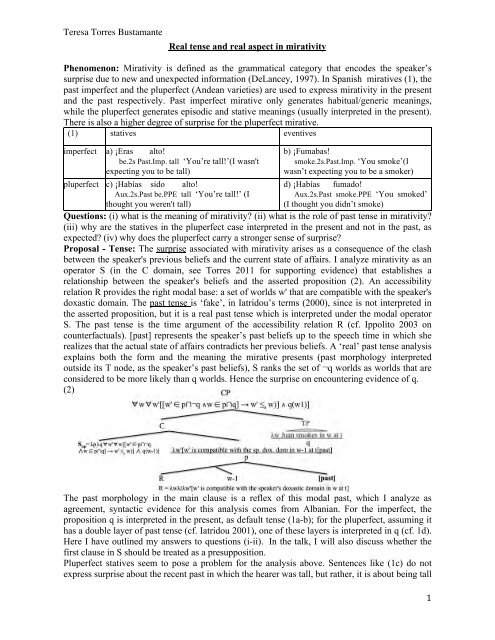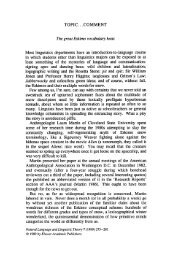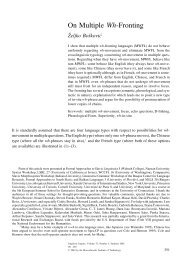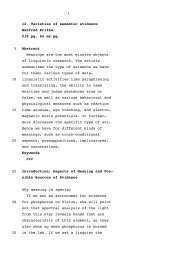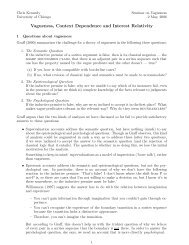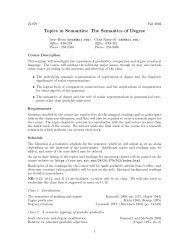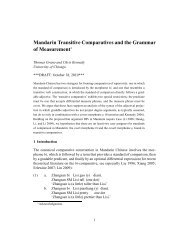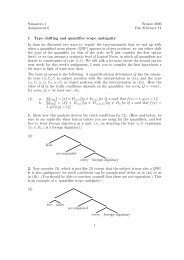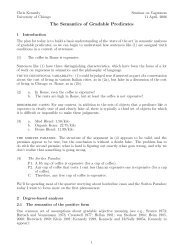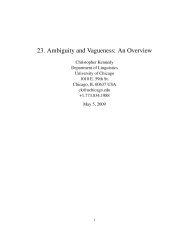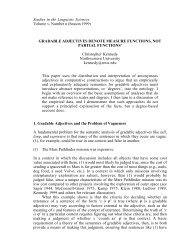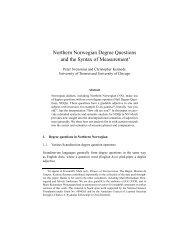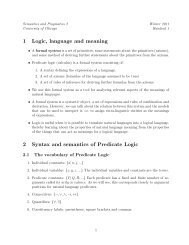On the natural history of negative polarity items - Syntax, Semantics ...
On the natural history of negative polarity items - Syntax, Semantics ...
On the natural history of negative polarity items - Syntax, Semantics ...
You also want an ePaper? Increase the reach of your titles
YUMPU automatically turns print PDFs into web optimized ePapers that Google loves.
Teresa Torres Bustamante<br />
Real tense and real aspect in mirativity<br />
Phenomenon: Mirativity is defined as <strong>the</strong> grammatical category that encodes <strong>the</strong> speaker’s<br />
surprise due to new and unexpected information (DeLancey, 1997). In Spanish miratives (1), <strong>the</strong><br />
past imperfect and <strong>the</strong> pluperfect (Andean varieties) are used to express mirativity in <strong>the</strong> present<br />
and <strong>the</strong> past respectively. Past imperfect mirative only generates habitual/generic meanings,<br />
while <strong>the</strong> pluperfect generates episodic and stative meanings (usually interpreted in <strong>the</strong> present).<br />
There is also a higher degree <strong>of</strong> surprise for <strong>the</strong> pluperfect mirative.<br />
(1) statives eventives<br />
imperfect a) ¡Eras alto!<br />
be.2s Past.Imp. tall ‘You’re tall!’(I wasn't<br />
expecting you to be tall)<br />
pluperfect c) ¡Habías sido alto!<br />
Aux.2s.Past be.PPE tall ‘You’re tall!’ (I<br />
thought you weren't tall)<br />
b) ¡Fumabas!<br />
smoke.2s.Past.Imp. ‘You smoke’(I<br />
wasn’t expecting you to be a smoker)<br />
d) ¡Habías fumado!<br />
Aux.2s.Past smoke.PPE ‘You smoked’<br />
(I thought you didn’t smoke)<br />
Questions: (i) what is <strong>the</strong> meaning <strong>of</strong> mirativity? (ii) what is <strong>the</strong> role <strong>of</strong> past tense in mirativity?<br />
(iii) why are <strong>the</strong> statives in <strong>the</strong> pluperfect case interpreted in <strong>the</strong> present and not in <strong>the</strong> past, as<br />
expected? (iv) why does <strong>the</strong> pluperfect carry a stronger sense <strong>of</strong> surprise?<br />
Proposal - Tense: The surprise associated with mirativity arises as a consequence <strong>of</strong> <strong>the</strong> clash<br />
between <strong>the</strong> speaker's previous beliefs and <strong>the</strong> current state <strong>of</strong> affairs. I analyze mirativity as an<br />
operator S (in <strong>the</strong> C domain, see Torres 2011 for supporting evidence) that establishes a<br />
relationship between <strong>the</strong> speaker's beliefs and <strong>the</strong> asserted proposition (2). An accessibility<br />
relation R provides <strong>the</strong> right modal base: a set <strong>of</strong> worlds w' that are compatible with <strong>the</strong> speaker's<br />
doxastic domain. The past tense is ‘fake’, in Iatridou’s terms (2000), since is not interpreted in<br />
<strong>the</strong> asserted proposition, but it is a real past tense which is interpreted under <strong>the</strong> modal operator<br />
S. The past tense is <strong>the</strong> time argument <strong>of</strong> <strong>the</strong> accessibility relation R (cf. Ippolito 2003 on<br />
counterfactuals). [past] represents <strong>the</strong> speaker’s past beliefs up to <strong>the</strong> speech time in which she<br />
realizes that <strong>the</strong> actual state <strong>of</strong> affairs contradicts her previous beliefs. A ‘real’ past tense analysis<br />
explains both <strong>the</strong> form and <strong>the</strong> meaning <strong>the</strong> mirative presents (past morphology interpreted<br />
outside its T node, as <strong>the</strong> speaker’s past beliefs), S ranks <strong>the</strong> set <strong>of</strong> ¬q worlds as worlds that are<br />
considered to be more likely than q worlds. Hence <strong>the</strong> surprise on encountering evidence <strong>of</strong> q.<br />
(2)<br />
The past morphology in <strong>the</strong> main clause is a reflex <strong>of</strong> this modal past, which I analyze as<br />
agreement, syntactic evidence for this analysis comes from Albanian. For <strong>the</strong> imperfect, <strong>the</strong><br />
proposition q is interpreted in <strong>the</strong> present, as default tense (1a-b); for <strong>the</strong> pluperfect, assuming it<br />
has a double layer <strong>of</strong> past tense (cf. Iatridou 2001), one <strong>of</strong> <strong>the</strong>se layers is interpreted in q (cf. 1d).<br />
Here I have outlined my answers to questions (i-ii). In <strong>the</strong> talk, I will also discuss whe<strong>the</strong>r <strong>the</strong><br />
first clause in S should be treated as a presupposition.<br />
Pluperfect statives seem to pose a problem for <strong>the</strong> analysis above. Sentences like (1c) do not<br />
express surprise about <strong>the</strong> recent past in which <strong>the</strong> hearer was tall, but ra<strong>the</strong>r, it is about being tall<br />
! "!


